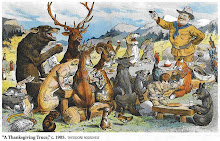http://feedproxy.google.com/~r/sciencedaily/plants_animals/ecology/~3/SyfcUvMYgPs/160308110006.htm?utm_source=feedburner&utm_medium=email
Mow less along highways, preserve pollinators, researchers say
Mowing less frequently along Florida's highways boosts pollinator and wildflower biodiversity and would likely save money on gasoline and manpower, new University of Florida research shows.
University of Florida Institute of Food and Agricultural Sciences researchers are studying how to preserve pollinators and wildflowers along the state's roadsides. Pollinators visit flowers, searching for food in the forms of nectar and pollen. During flower visits, pollinators may deposit pollen from a different flower. The plant uses the pollen to produce a fruit or seed. Many plants cannot reproduce without pollen carried to them by foraging pollinators.

The best-known pollinators are bees, but UF/IFAS researchers are studying butterflies as roadside pollinators. Among their other benefits, butterflies serve as indicator organisms. They signal when environmental changes are affecting ecosystems before the effects are apparent to humans or many other organisms, said Jaret Daniels, a UF/IFAS associate professor of entomology.

The best-known pollinators are bees, but UF/IFAS researchers are studying butterflies as roadside pollinators. Among their other benefits, butterflies serve as indicator organisms. They signal when environmental changes are affecting ecosystems before the effects are apparent to humans or many other organisms, said Jaret Daniels, a UF/IFAS associate professor of entomology.
Florida Department of Transportation officials supported UF scientists in the study and appreciate the results because they want to create an environment that fosters biodiversity and conserves critical ecosystem services like pollination, Daniels said. People sometimes complain to the FDOT when roadsides become overgrown with grass and flowers; thus, the department must mow to maintain aesthetics and clear an area for safety.
A March 2014 UF/IFAS report concluded that the FDOT could reduce right-of-way vegetation management costs by 30 percent by implementing sustainable management practices such as reduced mowing.
"Our new study will provide mowing recommendations for the FDOT," said Daniels, the faculty advisor for Dale Halbritter, a former UF/IFAS entomology masters student and current doctoral candidate, who led the research. "FDOT is committed to biodiversity conservation and ecological services that roadsides can offer. They additionally have a strong commitment to pollinator and monarch butterfly conservation."
"Mowing less frequently has the potential to accomplish the FDOT's objectives and enhance the abundance of floral resources," Daniels said. "More research is needed to determine the long-term impacts of different mowing regimes on Florida resources and pollinators in Florida."
For the study, researchers counted live and dead butterflies along roadways in Alachua County in the spring, summer and fall of 2011, during various FDOT mowing intervals. Although the study was conducted in Alachua County, its findings are applicable to other southeastern states, Daniels said.
They found butterfly mortality was reduced along roadways that were mowed less frequently.
The study by Daniels and Halbritter is published in the journal Florida Entomologist.
Story Source:
The above post is reprinted from materials provided by University of Florida Institute of Food and Agricultural Sciences. The original item was written by Brad Buck. Note: Materials may be edited for content and length.










No comments:
Post a Comment